Rugs are something which people do not buy frequently, with high quality rugs even being passed down through generations. Rugs are also a linked to ancient traditions as they have been used in homes since 2000 BC. Traditional rugs have the benefit of being eco-friendly and they give a natural and soothing look to the room. This makes them a great choice for decorating the house without worrying about the carbon footprint.
In modern times, almost every household has at least one rug somewhere in the house, hidden in different rooms increasing the aesthetic and functional value of the home. With traditional rugs being priced quite highly compared to some of the cheaper polypropylene rugs on offer, it is important to choose the right option for making the best use of it. This guide is an all-round source for getting information on traditional rugs, and where best to use them.
What materials are traditional rugs made of?
Traditional rugs may be made out of a single material or they may be formulated using a number of blended or braided natural fibres. The fibres which are used for making rugs are chosen based on their durability, ease of manufacture, cost and appearance. Although most of the rugs today are produced using polypropylene and poly-amides (nylons), traditional rugs are made only using natural materials since processed materials haven’t found their way into tradition yet.
Wool
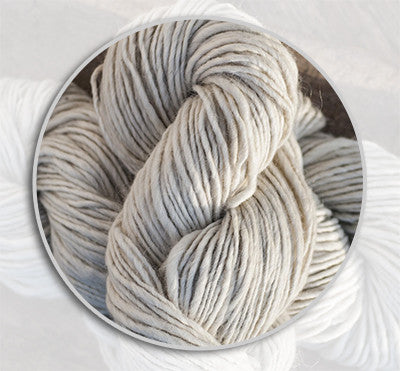
Wool is also a great choice for environment friendly people since it can be recycled and is also biodegradable in nature.
Wool can also be produced quite easily and abundantly with a very low carbon footprint due the low energy which goes into producing it. Other than this, wool also gives a luxurious feel and look to the rug while being quite durable. Wool is capable of shrugging off dirt particles easily and also resists stains effectively making it a great option to be used in rugs.
Silk
Silk is obtained from silkworms and is mainly produced in India and China. Silk has a luxurious feel to it owing to its silky texture and high sheen. While it may appear to be delicate and fine, it has an amazing durability. It is often mixed with wool to provide the rugs with astounding quality and appearance. Generally silk is used to make designs over a cotton base.
Silk is not only strong but is also resilient to dust and can be vacuumed easily. It is also quite easy to maintain these rugs and fresh stains can be simply removed using a damp towel.
Cotton
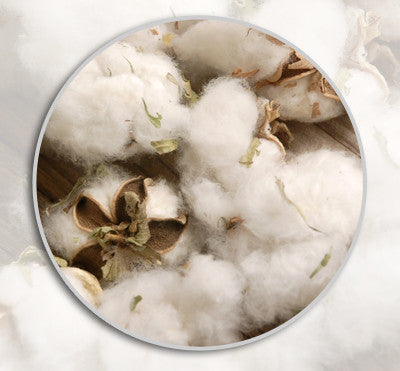
This natural fibre is grown round the globe and is widely used in America for making traditional rugs. China and India along with the U.S lead in exporting cotton fibres to the rest of the world. This natural fibre has a soft texture and lustre which makes it an ideal option for being used in textiles and clothes. As a matter of fact, cotton has been used for thousands of years for making textiles.
Although cotton is not as durable as wool, it is a breathable fibre and can be cleaned using a washing machine as well. These features make it a great choice for being used in rugs.
Bamboo
Being amongst one of the fastest growing plants around the world has made bamboo an abundant source for making less expensive rugs. Derived from Chinese culture, Bamboo rugs look like flat mats and can adapt well to casual needs while also being a true delight to be used on beaches. Since bamboo is a renewable source as it can be grown quickly, these rugs are eco-friendly as well. Although, people would want to clean spills quickly since wood absorbs stains quickly after which they become nearly impossible to remove. While their life depends on usage, these rugs can serve hassle free for up to 10 years.
Sisal
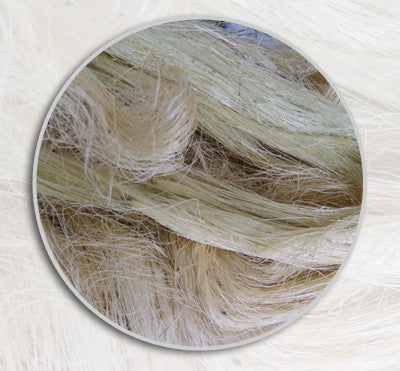
Sisal rugs give an organic look to the surroundings and are also eco-friendly in nature. Although they need regular vacuuming and are prone to stains, the cost of sisal rugs is quite affordable.
Jute
This is a natural fibre obtained from the Jute plant and is mainly imported from India and China to be used for a number of purposes. They are biodegradable and can be renewed easily due to their rapid growth during the rainy season. Jute is quite flexible along with being strong and durable in nature.
This fibre can be woven into tight chunks and braids without the fear of breaking them. Jute rugs can comfortably handle a medium to low amount of foot traffic and last for years with just a regular vacuum.
Hemp
This natural fibre has been used for millenniums in order to make textiles and is derived from the Cannabis plant. Today, they are mostly obtained from China, Canada and Australia to be used industrially. Hemp can grow easily in a number of climates over different types of terrain. The texture of hemp is similar to linen and it grows even softer with usage. With eco-friendly materials on the rise and an organic feel provided by traditional hemp rugs, these fibres have grown in popularity over the years. Hemp fibres can be easily dyed and they are also durable and tough, making them efficient in areas with high foot traffic as well. The Skandinavian Java range from Rug Culture are 100% Hemp - check them out here.
Seagrass
Providing the customers with a casual living look accompanied at an affordable price has made seagrass rugs quite popular in the recent decade or so. Seagrass grows beneath water in numerous parts around the world with most of it being supplied from Asia since the plants natively belong to monsoon climates.
Seagrass rugs have a smooth texture along with slight natural shine. Since seagrass grows in water, it does not absorb water or stains easily and can be easily managed. Natural sea grass fibres come in a wide variety of green undertones and are quite durable in nature.
Chenille
This velvety material has an origin in France and may be made using cotton, silk, wool or rayon through a twisting procedure. The base fibres are wound with long fibres at the required angle which gives rise to a luxurious material. Chenille is famed around the world owing to its textured look and amazingly soft appearance although it is not recommended for heavy foot traffic due to its construction.
Traditional Rug Making Techniques
There are different processes for making traditional rugs around the world. Commonly, there are three practices observed for making traditional rugs although other techniques may also be used collectively or exclusively for making traditional rugs. The amount of work and time given through each technique and the material used are the major factors which determine the price of a traditional rug.
Flat Woven Rugs
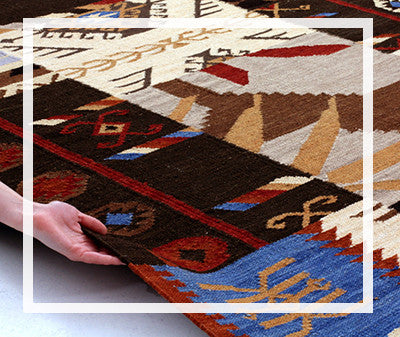
The most widely known types of flat rugs are Dhurries, Kilims, and Soumaks with the last one being the thickest at nearly 0.5 inches thick in some cases. The manufacturing of these rugs does not employ any adhesives at all and they are quite affordable in price.
Hand Made Rugs
The term “hand made rugs” can be used for a large variety of rugs which are made entirely by hand. These rugs are made usually through the lengthy process of drawing the design which is accompanied by sorting the wool and then dying it as required. When this has been done, individual knots are tied which is followed by shearing. After the process of shearing is complete, the rugs are sent for washing. Thus, a lot of work and time goes into making each rug and there are a vast number of designs in these handmade rugs making them truly unique. Larger number of knots does increase the price but it also increases the beauty to a great deal by adding to the intricacy of the design. Traditional Persian rugs can even have over 500 knots per square inch in some cases.
Machine Made Traditional Rugs
 These rugs are made on looms which are controlled electronically and programmed with the design and colour required for the rug. Machine-made rugs are produced in much lesser amount of time as compared to the other two processes and their precision is also monitored carefully. They are finished through binding the edges along with the addition of fridge if it’s desired. Their prices can vary greatly depending on their type and material used for making them but they are generally less expensive as compared to handmade traditional rugs. Although the difference is not readily apparent, upon close inspection, a machine made traditional rug and a handmade traditional rug can easily be differentiated from each other.
These rugs are made on looms which are controlled electronically and programmed with the design and colour required for the rug. Machine-made rugs are produced in much lesser amount of time as compared to the other two processes and their precision is also monitored carefully. They are finished through binding the edges along with the addition of fridge if it’s desired. Their prices can vary greatly depending on their type and material used for making them but they are generally less expensive as compared to handmade traditional rugs. Although the difference is not readily apparent, upon close inspection, a machine made traditional rug and a handmade traditional rug can easily be differentiated from each other.Influences of Traditional Rug Designs
The discovery of “the Pazyryk carpet” in Siberia during the mid-1900 century has given the oldest example of pile carpet and proved that rugs were used even in the 5th century BC (see our Rugs Throughout History post for more). These rugs were developed by Mesopotamian nomads and were then introduced into Persia. Rugs have been around for over 4000 years according to speculations and the techniques used today for making them still resonate with those used in the ancient times.
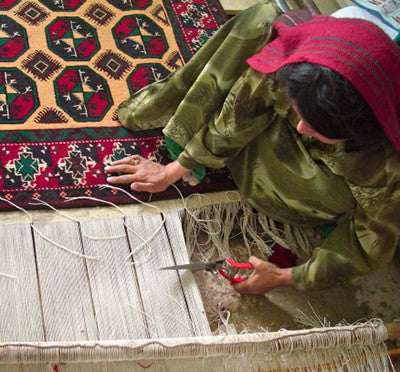
In around 1000 AD, the art of weaving pile rug started in Europe but this was mainly influenced by Egyptians as they were located nearby and proved to be great sources for knowledge and information regarding rug making. Thus, Egypt also contributed to traditional rug designs by a great extent.
How to match traditional rugs with home décor?
Traditional rugs can be matched with home décor using both contemporary and classic styles. There is no reason for a traditional rug to look bad with modern décor if it is planned well whereas bad placing can even make classic furniture look bad with a traditional rug. There are a few factors which people need to focus on in order to match their rugs perfectly while there are several other tips as well which they can follow to achieve a spellbinding interior.
The important factors to note for matching the traditional rugs with home decor are given below:
Defining areas:
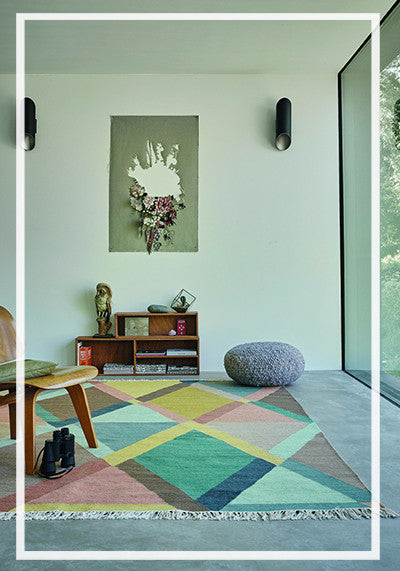
Use different sizes and complementing styles:
If placing more than one rug in the same room, it is better to use different sizes. Using different sized rugs creates a sense of variety and makes the room look livelier. Having different sizes also does not cut the room into pieces visually. Using rugs which do not complement each other in their style may lead to a jarred interior with unpleasant effects.
Colour scheme should be paid attention to: A rug can either be the basis of the colour scheme or it can be used to accent or tie the already existing colours in the room. People can also use a non-white rug to provide a counterbalance to deep coloured glossy walls in their house. It is also quite easy to repeat the warm rug colours through pillows and other artwork to create a smooth look in the area. Here's a helpful guide to determine the right rug color for your space.
Using a bold or a subtle rug:
A room should only have limited features that stand out. If the upholstery is having an ornate pattern or the mantelpiece is crafted intricately then it is better to use a subtle rug. On the other hand, if the walls and other features of the room are subdued, then people can go for a rug with bold colours and busier patterns for adding more interest.

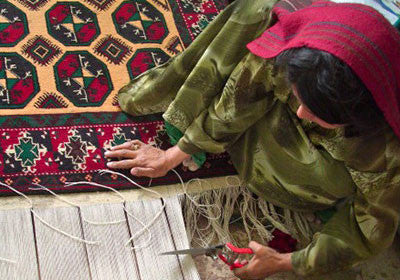
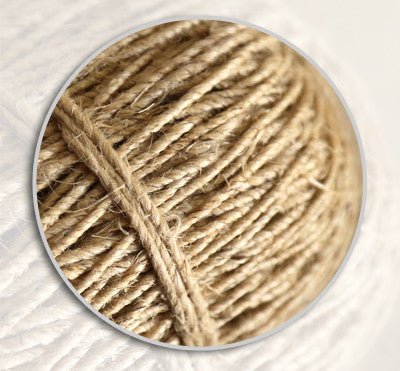

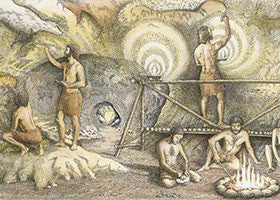
Leave a comment
All comments are moderated before being published.
This site is protected by reCAPTCHA and the Google Privacy Policy and Terms of Service apply.